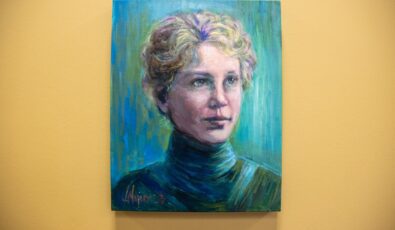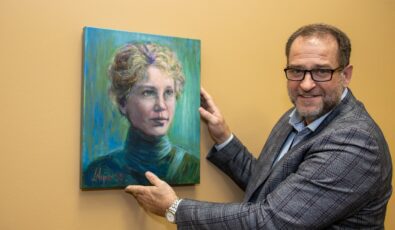OPG showcases nuclear pioneer Harriet Brooks with new ‘Great Women’ portrait
At a glance
- OPG has unveiled a new portrait of Harriet Brooks, the first Canadian female nuclear physicist.
- The painting is part of the Great Women Portrait Project, which uses portrait art to highlight important female innovators while inspiring current and future generations.
- Brooks’ portrait is also being unveiled at offices across Canada’s energy sector.

OPG is paying tribute to one of the founding women in the Canadian nuclear field.
In October, the company unveiled a new portrait of Harriet Brooks, a physicist and nuclear scientist who made many important contributions to the field of atomic physics in the early 20th century.
Created by Halifax artist Jo Napier as part of the Great Women Portrait Project, the portrait was commissioned by five nuclear-sector female executives to highlight Brooks’ achievements while promoting equity, diversity, and inclusion (ED&I) across the energy sector.
The new painting now hangs proudly at OPG’s Darlington Energy Complex, as well as on the walls of other energy utilities as part of an effort to roll out the portrait across the sector.
We are excited to pay tribute to this nuclear pioneer, and empower the future women of nuclear, through the unveiling of this wonderful new portrait.Boris VulanovicSenior Vice-President of Nuclear Refurbishment
“As the first Canadian female nuclear physicist, Harriet Brooks played a major role in helping us understand radioactivity and nuclear physics,” said Boris Vulanovic, OPG’s Senior Vice-President of Nuclear Refurbishment. “Her groundbreaking discoveries helped pave the way for nuclear power as well as nuclear medicine, both of which continue to enrich society today. We are excited to pay tribute to this nuclear pioneer, and empower the future women of nuclear, through the unveiling of this wonderful new portrait.”

As the first woman to receive a master’s degree from McGill University in 1901, Brooks discovered that one element could change into another element through radioactive decay.
She discovered the radioactive gas radon in 1900 while she was still a student. This was a significant find, as radon is one of the decay products of uranium and a key component in understanding radioactivity. Her work on radon has continued to be important, especially in understanding radon’s health hazards.
She also worked under Ernest Rutherford and Marie Curie, two pioneering researchers in radioactivity and nuclear physics, and held a variety of university positions, including at McGill and Barnard College in the U.S.
She died in 1933 at the age of 56.
While Brooks’ new portrait celebrates her remarkable story, it is also meant to shed light on the systemic barriers she faced in her time, and the barriers women in STEM fields continue to face.
The Great Women Portrait Project encourages female leaders in diverse industries to use portrait art to advocate for women, educate this generation, and inspire the next.
“It is important that we as an industry visibly celebrate important female pioneers and innovators like Harriet Brooks through projects like this,” said Vulanovic. “Building a more diverse, inclusive, and equitable workplace is critical to our future success. We must continue to support and celebrate women and girls in STEM fields and in the energy industry. It is through their diverse voices, perspectives, and skills that we will build a stronger future.”
Subscribe and stay informed
Sign up to receive the latest news, project updates, and event information from OPG.


